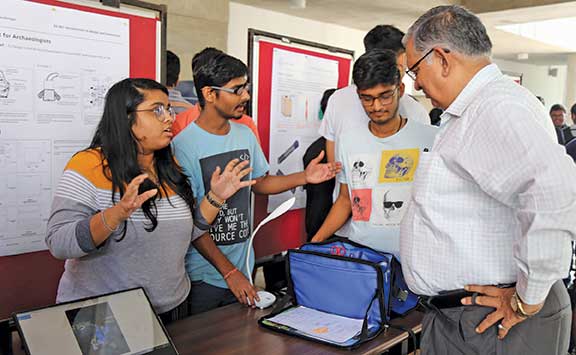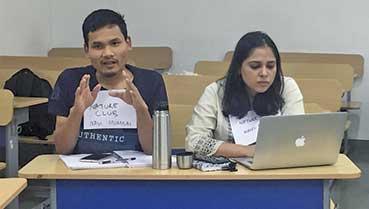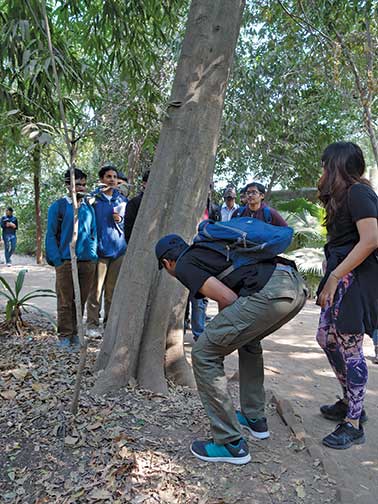Manasi Kanetkar and Ambika Aiyadurai
As teachers at Indian Institute of Technology, Gandhinagar (IITGN), one of our ongoing discussions is about our experiences, learnings, and challenges of teaching design and humanities in an engineering institute. Our goal is to enhance and enrich students’ experiences inside and outside the class. As B.F. Skinner an American psychologist, inventor, and social philosopher once said, “The real problem is not whether machines think but whether men do.” The quote suggests that we should focus on nurturing human values and critical thinking rather than on making machines intelligent. We believe that our learning as teachers in a science and technology institute would be applicable to any teacher who would like to make classroom experiences more interesting and impactful for students.

Students joining IITs come from varied backgrounds – social, geographical and ethnic. What is common among them is the grind they go through during the Joint Entrance Examination (JEE) preparations. Students are initially apprehensive about taking humanities and social sciences or design courses seriously. Many of them feel these courses do not add much value to their education but attend them since they are compulsory. As teachers, we are aware of their expectations, limitations, and anxieties.
IITGN has implemented multiple new initiatives including project-based learning modules, design-based engineering courses, a wide and varied basket of elective courses, new options for minors, and an emphasis on a well-rounded education.
IITGN runs a novel orientation programme called Foundation Programme for its incoming first-year BTech students focusing on values and ethics, social awareness, creativity, teamwork, and physical fitness. With a vision for an innovative undergraduate programme, the curriculum is designed to nurture future engineers with the ability to think critically and apply their training to social contexts. Students of IITGN have to take a mandatory course called ‘Design, Innovation and Prototyping’ and mandatorily also earn a set of credits from a pool of humanities and social sciences.
This approach also resonates with the important aspects of the NEP 2020. NEP 2020’s thrust is towards creating holistic and well-rounded students and to make space for critical thinking and inquiry-based, discovery-based, discussion-based, and analysis-based learning. Under the section ‘Curriculum and Pedagogy in Schools’ NEP 2020 stipulates that learning should be holistic, integrated, enjoyable, and engaging.
Taking cognizance of the demography of the students (age, social background, disciplines) and the diversity of courses they have to go through, we begin these courses by explaining the importance of design and humanities offered in IITGN and why students should take interest in them rather than thinking of them as a burden or liability to fulfil the credit requirements. We emphasize a creative, collaborative approach with hands-on activities and active participation.
Pedagogical strategies
Our objective in teaching design and HSS courses is not only to make the students learn about design methodology or sociology but also to apply these as creative yet systematic problem-solving processes. For example, students identify real life issues such as ‘transportation of building material on construction sites’, or ‘portable seating for street vendors’. Through this approach, the courses ensure that while applying technology, the students keep in mind the users’ needs. To achieve this, we encourage students to work in groups, collaborate with their peers, and encourage them to think out-of-the-box. Students make models or prototypes to materialize the ideas as well as develop the skills of sketching and material handling while developing ideas.

Another challenge we face is to connect or make students aware or sensitized to the ‘real’ social world. Our HSS courses aim to address this gap. Similar to the design courses that focus on people and their needs, HSS courses also aim to bring the concerns of people at the centre of the teaching and learning processes. We use various pedagogical tools in both design and HSS classrooms and beyond. Some of them are listed below.
- Role plays
To motivate and keep students engaged in the class role-plays are effective. Role-plays can offer real-life situations, expose students to diverse opinions from other group members and also put them in a situation that could be contrary to their opinions. In the class on environment and development, role-plays on dams and national parks help students to understand the complexity of the ground realities when there are multiple interest groups with not-so-similar agendas. We conduct these with a diverse group of students that includes both undergraduates and post-graduates. With very limited resources and conducted within the classroom, role-plays teach about negotiation, cooperation, and also persuasion since every student gets to participate and put across their views. Towards the end, students realize the relevance and importance of considering other actors and their standpoints. Role-plays help in inculcating empathy and compassion for those different from their own social position. - Audio-visual media
Visual media are powerful tools and can take the form of diagrams, charts, video as well as infographics. Appropriate use of these media can make communication and recall of knowledge topics very effective. We incorporate such tools in our lecture sessions whenever relevant, so that the students retain and recall the synopsis effortlessly. While working on the projects and assignments we guide the students to use sketching as a thinking tool and models or computer-generated simulations to explain their concepts. They are also encouraged to use their smartphone cameras to record and present audio-visual data such as interviews of people or pictures of the environment. This not only helps them present their ideas, but also sensitizes them to utilize the new media appropriately. - Use of props
Taking props to the classroom helps in breaking the monotony of lecture-based teaching and increases curiosity among the students. They find it easy to engage in a discussion. Passing the prop around the class is a memorable experience. Both in the design and social science classes, we carry props to the class. For example, objects that depict animals and birds help in discussing animal symbolism. An image or a small statue of an elephant can elicit various responses leading to multiple ways of understating human-animal relations. For example, a student remarked that the course on environment enabled them to go beyond conventional academics to the real issues of socio-environmental issues. - Field trips
Field trips are a highlight in the social science courses and a mandatory part. Students are required to take part and submit a report after the trip for assessment. Field trips were arranged to Gir National Park, Nalsarovar Sanctuary, Pirana landfill, and Gandhinagar landfill for the environment course. In the field, students conduct a short survey with the local people and the community members. These experiences from the field can hardly be created in a classroom setting. The hands-on activities empower students to undertake research projects confidently, develop critical thinking, and build their skills in becoming independent researchers.

Our learnings as teachers
Using a creative pedagogical approach could lead to balancing freedom of thought, creativity vs. logical approach to understand topics in humanities and design. Instead of bombarding students with theories, our style of teaching begins with activities, followed by group discussions directed through a set of questions and then building on theories.
We have so far received an enthusiastic response from many students, during and after the course. Interactive classrooms involving activities and encouraging open-ended debates make sure that students start talking and thinking about complex environmental, sociological, and other systemic issues. They start appreciating multiple perspectives rather than looking for a singular answer to problems posed to them. The in-class activities and field-trips help to broaden their vision of going beyond one particular discipline.
Testimonies from students
One of the alumni has said, “The design courses at IITGN enabled me to step outside my engineering approach of looking for a metric for assessing the world and instead learn how to appreciate and work with the grey areas around me.”
Another student expressed, “I feel an exposure to such courses will help in bringing out a drastic change in the existing monotonous and routine coursework and will help students develop better understanding of their subjects.”
Yet another student mentions, “I had the opportunity to try out different approaches to solve problems that arose while working on projects, such as trying out different materials. The experience taught me how insightful an issue can be when approached from a different perspective.”
Conclusion
In conclusion, we are confident that approaches such as role plays and classroom activities are effective for all students. Identifying, defining and understanding problems from a holistic perspective will bring in the much-needed changes in education whether in high school or higher studies. These activities also increase the students’ ability to think about possible solutions that are socially relevant and viable.
Manasi Kanetkar is Associate Teaching Professor in Design and Co-coordinator of the Design and Innovation Centre, IITGN. She can be reached at manasi.kanetkar@iitgn.ac.in.
Ambika Aiyadurai is Associate Professor with the department of Humanities and Social Sciences, IITGN she can be reached at a.ambika@iitgn.ac.in.
